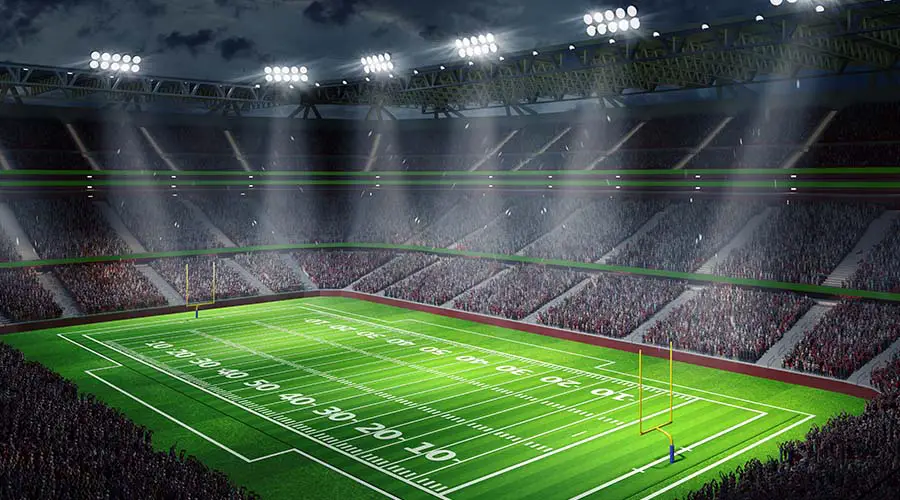American football is a team sport that involves strategy, strength and skill. The aim of the game is to advance the ball into the opponent’s scoring zone, or to prevent the opponent from doing the same.
As with any competitive sport, there are specific rules that players must follow. They may seem complex at first, but once you understand the system, everything makes sense.
It was with this in mind that we decided to produce this complete and up-to-date guide to the rules of American football. Precisely to show you that the sport of the oval ball is not a seven-headed beast.
In the content below, you’ll learn about the types of scores, understand how yardage progression works and get to grips with the main plays.
Check it out 👇
American football rules
- Basic fundamentals of american football
- American football match duration
- American football progression system
- American football scoring system
- Fouls in american football
- American football pitch dimensions
- American football equipment
Basic fundamentals of american football
American football is a team sport known for its combination of physical strength, tactical strategy and speed. The game is played between two teams of 11 athletes on a 120-yard-long pitch.
The aim is to score points using combinations of moves. At the end of the match, the team with the highest score is declared the winner.
Points can be scored in two different ways: by entering the opponent’s scoring zone with the ball (through the hands) or by hitting it between the opponent’s posts (through kicks).
The sport is known for its strategic complexity, as teams need to execute a variety of offensive and defensive moves in order to score points and, at the same time, avoid opposition attacks.
American football match duration

An American football match in the National Football League (NFL) is divided into four quarters of 15 minutes each. That’s the timed time.
If we take broadcasting time into account, the game can last for hours, as there are several breaks, replays and timeouts.
American football progression system
Each team starts its possession with a fixed number of attempts, called “downs”. In total, there are four downs to advance at least 10 yards (approximately 9.144 metres) down the field.
The goal, then, is to advance 10 yards to gain four more downs. And so on, until the team manages to reach the opposition’s scoring zone, also known as the endzone.
If the attacking team fails to advance 10 yards in four downs, possession is transferred to the opposing team from where the last unsuccessful play ended.
There is, however, a way to score before handing possession back. If the attacking team is close to the opponent’s base, they can try to hit a shot between the posts to score three points.
This is called a field goal.
American football scoring system

The scoring system in American football is very diverse, allowing teams to accumulate points in various ways during the game. We’ve listed the main ways below. Check them out:
- Touchdown | The touchdown is worth six points. To score it, the player must enter the opposing endzone with the ball in his possession;
- Extra point | After a touchdown, the team has the option of attempting an extra point, which is a short field goal kick. If the kick is successful, the team gets a point, totalling seven points on the play (6 points from the touchdown + 1 extra point);
- Extra point advancement | After the touchdown, the team can also choose to attempt a two-point conversion, which involves an additional play from the opponent’s two-yard line. If successful, the team earns two additional points;
- Field goal | When the team has possession of the ball but is not sure it will score a touchdown, it can attempt to kick a field goal from anywhere on the field. If the ball goes between the posts, the team is awarded three points;
- Safety | A safety occurs when the defensive team knocks down a player from the offensive team in their own end zone. This play is worth two points.
Fouls in american football
Infractions in American football, also known as penalties, occur when a team violates the rules established during the game.
Penalties can result in a loss of yards, additional downs for the attacking team, or even changes in possession. Here are a few:
- Holding | It is forbidden to hold players who are without the ball, only those in possession. For those without the ball, only pushing is allowed;
- False start | When a player moves before the ball is put into play, a foul is called;
- Delay of game | Teams have 40 seconds to position themselves and put the ball into play. A foul is called if this limit is exceeded;
- Helmet grid | It is forbidden to hold the opponent’s helmet grid. This action is punishable by a foul;
- Unnecessary violence | When a player uses excessive violence to stop an opponent, a foul may be called.
American football pitch dimensions

The American football pitch in the National Football League (NFL) has regulatory dimensions that contribute to the dynamics of the game.
The length of the pitch is 120 yards. Included in this total area are the two endzones, which measure 10 yards each. In terms of width, the American football pitch is 53.3 yards long.
It’s worth remembering that the pitch is marked every 10 yards along the sides, making it easier to identify the position of the ball and the team’s progress.
American football equipment
American football players have to wear a lot of compulsory equipment, such as helmets. This accessory is used to protect the head from the great physical impacts of the game.
In addition to the helmet, athletes must also wear: shoulder pads, a rib protector, a neck protector, a mouth protector, a thigh protector, knee pads, shin pads, a hip belt, gloves and boots.
Now you know the main rules of American football! Did you like this content? Leave your opinion in the comments! And keep visiting us every day for more articles on games and sports 👊



